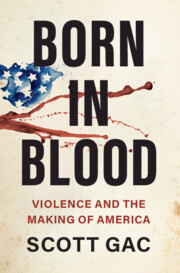Book contents
- Born in Blood
- Born in Blood
- Copyright page
- Dedication
- Epigraph
- Contents
- Figures
- Introduction A System of Violence: Liberal Society in the United States
- Part I Early Manifestations
- Part II Evolutions
- 4 The 1850s: A People’s Government and the Politics of Belligerence
- 5 The United States Greets John Brown
- 6 1860: The Undisputed Election that Sparked Dispute
- 7 Emancipation’s Fury
- Part III Modern Traditions
- Acknowledgements
- Notes
- Index
7 - Emancipation’s Fury
from Part II - Evolutions
Published online by Cambridge University Press: 18 January 2024
- Born in Blood
- Born in Blood
- Copyright page
- Dedication
- Epigraph
- Contents
- Figures
- Introduction A System of Violence: Liberal Society in the United States
- Part I Early Manifestations
- Part II Evolutions
- 4 The 1850s: A People’s Government and the Politics of Belligerence
- 5 The United States Greets John Brown
- 6 1860: The Undisputed Election that Sparked Dispute
- 7 Emancipation’s Fury
- Part III Modern Traditions
- Acknowledgements
- Notes
- Index
Summary
The centrality of slavery in the North and South, Black resistance, and the greatest shift in the domestic use and formation of federal force form the foundation of Chapter 7. Here, the likes of Robert Smalls, an enslaved boat pilot in South Carolina, the hundreds of thousands of Civil War slave fugitives, Union and Confederate military leaders, President Abraham Lincoln, President Jefferson Davis, and others address the consequences of one question: should the United States deploy its forces, its violence, in support of slaveholders or freed slaves?
Keywords
- Type
- Chapter
- Information
- Born in BloodViolence and the Making of America, pp. 157 - 188Publisher: Cambridge University PressPrint publication year: 2024

